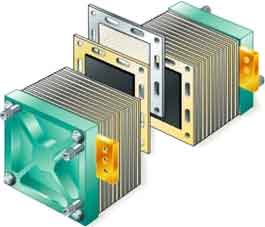A new research project at Rensselaer Polytechnic Institute aims to tackle the challenge of how to mass produce fuel cell stacks by using robotic assembly.
The project, which will combine the resources of
“The US Department of Energy has suggested that the cost of manufacturing fuel cells is the single biggest obstacle on the road to the hydrogen economy,” says Raymond Puffer, co-director of the FMC. “We are addressing a component that represents a major portion of the total systems cost: the stack assembly in a proton exchange membrane (PEM) fuel cell.”
In a PEM fuel cell, hydrogen is split into protons and electrons on one side of a thin polymer membrane. The membrane allows protons to pass through, but electrons are forced to go around, creating a flow of electrical current. On the other side of the membrane, the electrons recombine with the protons and with oxygen from the air, creating water and heat as the only byproducts. To produce enough energy for most applications, multiple fuel cells are combined in a fuel cell stack.
“It is currently common to take as long as a full day to assemble and leak-test a single stack,” says Stephen Derby, FMC’s other co-director. “To be commercially viable, stack assembly must be accomplished in minutes, not hours.”
Derby, Puffer, and their colleagues already have applied their expertise in automating manufacturing processes through a collaboration with PEMEAS, a supplier of high-temperature membrane electrode assemblies (MEAs) for PEM fuel cells. In 2002 the researchers developed a fully automated $5 million MEA pilot manufacturing line at the company’s plant in
To begin addressing the PEM stack assembly process, the researchers plan to create a flexible robotic “workcell,” which will include various pieces of robotic equipment designed to handle materials with great precision.

The RIA award includes three full industrial robot systems, donated by the Kuka Robot Group, and collision-avoidance sensors for the systems, provided by RAD, a robotics accessories supplier.
“Many of the materials in PEM stacks are thin, flexible, soaked in corrosive acids, or highly sensitive to changes in humidity and temperature,” Puffer says. “This makes material handling orders of magnitude more difficult than methods used for simple flexible materials such as paper.” The researchers will use existing automated methods to gain a deeper understanding of how PEM stack materials respond to various handling techniques, while also researching new ways to sense material properties throughout the process.
Additional research support will be sought from federal agencies as well as an industry consortium, with the goal of increasing the understanding of the PEM stack assembly process across the entire robotics industry.
The researchers will give a final report in two years at the next International Robots & Vision Conference in 2007.




April 1886: the Brunkebergs tunnel
First ever example of a ground source heat pump?